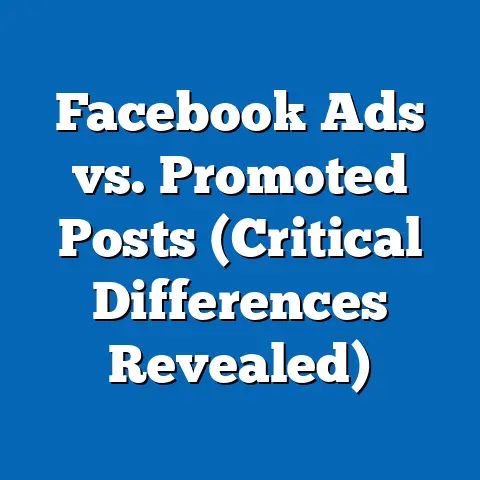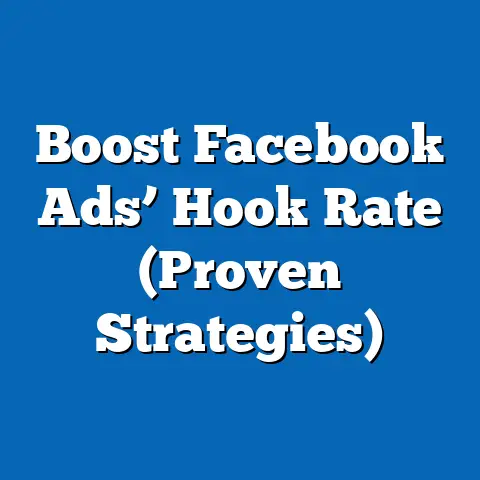Adjust Facebook Ads Billing Date (Ultimate Guide)
As a digital marketing specialist who has spent years navigating the ever-changing landscape of Facebook advertising, I’ve learned one thing: future-proofing your strategies is paramount. The digital world moves at warp speed, and what works today might be obsolete tomorrow. That’s why understanding and managing seemingly simple aspects like your Facebook Ads billing date can have a significant impact on your overall advertising success.
Think of it like this: you’re building a house, and your advertising budget is the foundation. If that foundation is shaky, the whole structure could crumble. Managing your billing date is like ensuring your foundation is solid and aligned with your financial capabilities. It’s about proactively taking control of your ad spend and ensuring it aligns with your business’s financial rhythms.
In the context of Facebook advertising, future-proofing means anticipating changes, adapting to new features, and optimizing your campaigns for long-term success. A key element of this is managing your billing dates. It’s not just a matter of when you pay; it’s about strategically aligning your advertising spend with your cash flow, optimizing campaign performance, and maximizing your return on investment (ROI).
Why is this so important? Consider this: a recent study showed that nearly 60% of small businesses struggle with cash flow management. If your Facebook Ads billing cycle clashes with your business’s revenue cycle, you could find yourself in a bind, potentially jeopardizing your campaigns and overall business growth. This guide is about preventing that scenario and empowering you to manage your advertising finances with confidence. Let’s dive in!
Section 1: Understanding Facebook Ads Billing
Before we get into adjusting your billing date, it’s crucial to understand the fundamentals of Facebook Ads billing. I’ve seen countless advertisers stumble because they didn’t grasp the basics, leading to unexpected charges, disrupted campaigns, and even account suspensions. Let’s avoid that!
How Facebook Ads are Billed
Facebook Ads operate on an auction-based system. You set a budget, define your target audience, and create your ad. Facebook then enters your ad into an auction with other advertisers targeting similar audiences. The winners of the auction get their ads shown to users.
The cost of your ads depends on factors like your target audience, ad quality, bidding strategy, and the competition in the auction. You’re essentially paying for impressions (the number of times your ad is shown) or clicks (the number of times people click on your ad).
Payment Methods on Facebook Ads
Facebook offers various payment methods to suit different advertisers’ needs. These typically include:
- Credit Cards: The most common and straightforward option. Facebook accepts major credit cards like Visa, Mastercard, American Express, and Discover.
- Debit Cards: Similar to credit cards, but linked directly to your bank account.
- PayPal: A popular online payment platform.
- Local Payment Methods: Depending on your region, Facebook may offer local payment options like direct bank transfers or mobile payment solutions.
I always recommend using a dedicated credit card for your Facebook Ads. This allows you to easily track your ad spend and separate it from your other business expenses. It also provides an extra layer of security and potential rewards points.
Billing Cycles Explained
Facebook Ads billing cycles are based on two primary factors:
- Billing Threshold: This is the amount you spend on ads before Facebook charges you. The threshold starts low (e.g., $25) and gradually increases as you consistently pay your bills on time.
- Billing Date: This is the date on which Facebook charges you, regardless of whether you’ve reached your billing threshold.
Facebook will bill you whenever you reach your billing threshold or on your billing date, whichever comes first. For example, if your billing threshold is $50 and your billing date is the 15th of the month, Facebook will charge you $50 whenever you spend that amount or on the 15th, even if you haven’t spent the full $50.
Manual vs. Automatic Payments
Facebook offers two main billing options:
- Automatic Payments: This is the default setting. Facebook automatically charges your payment method whenever you reach your billing threshold or on your billing date. This is generally the most convenient option.
- Manual Payments: This option allows you to add funds to your Facebook Ads account before your ads run. You’re essentially paying upfront. This can be useful if you want to strictly control your ad spend or if you have a limited credit line.
While manual payments offer more control, I’ve found that automatic payments are generally more efficient for most businesses. They ensure your ads keep running without interruption, as long as your payment method is valid and your account is in good standing.
Common Billing Scenarios
Here are a few common billing scenarios that advertisers often encounter:
- Reaching the Billing Threshold Early: If your campaigns are performing well and you’re spending more than expected, you might reach your billing threshold before your billing date. In this case, Facebook will charge you as soon as you hit the threshold.
- Not Reaching the Billing Threshold: If your campaigns are running slowly or you’ve paused them, you might not reach your billing threshold before your billing date. In this case, Facebook will charge you for the amount you’ve spent up to that date.
- Failed Payments: If your payment method is declined, Facebook will pause your ads and notify you. You’ll need to update your payment information to resume your campaigns.
- Unexpected Charges: Sometimes, advertisers are surprised by unexpected charges. This can be due to various factors, such as running multiple campaigns, forgetting to pause ads, or changes in your bidding strategy.
Key Takeaway: Understanding the Facebook Ads billing process is essential for managing your ad spend effectively. Familiarize yourself with the different payment methods, billing cycles, and billing options. This will help you avoid unexpected charges, maintain a healthy advertising budget, and optimize your campaign performance.
Next Steps: Review your current Facebook Ads billing settings. Check your billing threshold, billing date, and payment method. Make sure everything is accurate and up-to-date. This is the first step towards taking control of your advertising finances.
Section 2: The Importance of Adjusting Your Billing Date
Now that we’ve covered the basics of Facebook Ads billing, let’s delve into why adjusting your billing date can be a game-changer for your advertising strategy. I’ve personally witnessed the positive impact this simple adjustment can have on businesses of all sizes.
Maintaining a Healthy Advertising Budget
Adjusting your billing date allows you to align your Facebook Ads spend with your business’s cash flow cycle. This is particularly crucial for small businesses and startups with limited resources. By syncing your billing date with your revenue cycle, you can ensure you have sufficient funds available to cover your advertising expenses.
Imagine you’re a small e-commerce business that experiences a surge in sales during the holiday season. If your Facebook Ads billing date falls in the middle of the month, you might struggle to pay your ad bills if your revenue hasn’t come in yet. By adjusting your billing date to the end of the month, you can ensure you have the funds available to cover your advertising expenses.
Cash Flow Management
Cash flow is the lifeblood of any business. By strategically adjusting your billing date, you can improve your cash flow management and avoid unnecessary financial strain. This is especially important during periods of slow sales or unexpected expenses.
I remember working with a client who was struggling to manage their cash flow. They were constantly worried about having enough money to pay their bills, including their Facebook Ads bill. By adjusting their billing date to align with their payment cycle, we were able to alleviate their financial stress and improve their overall cash flow management.
Impact on Campaign Performance
If your billing date is not aligned with your business’s cash flow cycle, you might be forced to pause your campaigns due to insufficient funds. This can have a negative impact on your campaign performance, as it disrupts your momentum and reduces your reach.
Consistency is key in advertising. Pausing your campaigns can lead to a loss of momentum, reduced reach, and ultimately, lower ROI. By adjusting your billing date, you can ensure your campaigns run continuously without interruption, maximizing your results.
Case Studies and Scenarios
Let’s look at a few hypothetical scenarios to illustrate the benefits of adjusting your billing date:
- Scenario 1: The Startup with Limited Resources: A startup launches a new product and invests heavily in Facebook Ads to drive initial sales. However, their billing date falls in the middle of the month, and they often struggle to pay their bills on time. By adjusting their billing date to the end of the month, they can align their ad spend with their revenue cycle and avoid financial strain.
- Scenario 2: The Seasonal Business: A seasonal business experiences a surge in sales during certain months of the year. If their billing date is fixed, they might overspend during slow months and underspend during peak months. By adjusting their billing date to align with their seasonal revenue cycle, they can optimize their ad spend and maximize their ROI.
- Scenario 3: The Business with Multiple Revenue Streams: A business has multiple revenue streams with different payment cycles. By adjusting their billing date to align with their primary revenue stream, they can simplify their cash flow management and ensure they have the funds available to cover their advertising expenses.
Key Takeaway: Adjusting your Facebook Ads billing date is not just a matter of convenience; it’s a strategic decision that can significantly impact your advertising budget, cash flow management, and campaign performance. By aligning your billing date with your business’s financial rhythms, you can optimize your ad spend, avoid financial strain, and maximize your ROI.
Next Steps: Analyze your business’s cash flow cycle. Identify the periods when you have the most and least revenue. Determine if your current Facebook Ads billing date aligns with your cash flow cycle. If not, consider adjusting your billing date to optimize your financial management.
Section 3: Step-by-Step Guide to Adjusting Your Billing Date
Now, let’s get to the practical part: how to actually adjust your billing date in Facebook Ads Manager. I’ll provide a clear, step-by-step guide with screenshots to make the process as easy as possible. I know navigating Facebook’s interface can sometimes feel like navigating a maze, so I’m here to guide you through it.
Important Note: Facebook’s interface is constantly evolving, so the exact steps might vary slightly. However, the general principles remain the same.
Prerequisites
Before you can adjust your billing date, make sure you meet the following prerequisites:
- Active Facebook Ads Account: You need to have an active Facebook Ads account with a valid payment method.
- Administrator Access: You need to have administrator access to the ad account.
- No Outstanding Balance: You need to have a zero balance. Facebook will not let you change the billing date until the balance is cleared.
Step-by-Step Instructions
-
Access Facebook Ads Manager:
- Log in to your Facebook account.
- Navigate to Facebook Ads Manager. You can usually find it by clicking on the menu icon in the top right corner of your Facebook page and selecting “Ads Manager.”
 [Replace with a screenshot of accessing Facebook Ads Manager]
[Replace with a screenshot of accessing Facebook Ads Manager] -
Go to Billing Settings:
- In Ads Manager, click on the menu icon (usually three horizontal lines) in the top left corner.
- Select “Billing” from the dropdown menu.
 [Replace with a screenshot of accessing Billing Settings]
[Replace with a screenshot of accessing Billing Settings] -
Review Billing Summary:
- The Billing page provides an overview of your billing history, payment methods, and billing settings.
- Take a moment to review your current billing date and billing threshold.
 [Replace with a screenshot of the Billing Summary]
[Replace with a screenshot of the Billing Summary] -
Edit Billing Date (If Available):
- Here’s the catch: Facebook doesn’t directly offer an option to change your billing date.
- Instead, you can influence the billing date by managing your ad spend and payment methods.
-
Managing Ad Spend to Influence Billing:
- Adjusting Daily Budgets: If you want to be billed sooner, you could increase your daily ad budgets, which will lead to reaching your billing threshold faster.
- Pausing Campaigns: If you want to delay billing, you can pause your campaigns to reduce ad spend.
-
Managing Payment Methods to Influence Billing:
- Adding a New Payment Method: Adding a new payment method can sometimes trigger a billing cycle.
- Removing and Re-adding a Payment Method: Removing and then re-adding your payment method might also influence the billing date. However, this is not a guaranteed method and should be done with caution.
-
Contacting Facebook Support:
- If you have a specific reason for needing to adjust your billing date (e.g., a change in your business’s financial cycle), you can try contacting Facebook support directly.
- Explain your situation and see if they can offer any assistance.
 [Replace with a screenshot of contacting Facebook Support]
[Replace with a screenshot of contacting Facebook Support]
Access Facebook Ads Manager:
- Log in to your Facebook account.
- Navigate to Facebook Ads Manager. You can usually find it by clicking on the menu icon in the top right corner of your Facebook page and selecting “Ads Manager.”
 [Replace with a screenshot of accessing Facebook Ads Manager]
[Replace with a screenshot of accessing Facebook Ads Manager]
Go to Billing Settings:
- In Ads Manager, click on the menu icon (usually three horizontal lines) in the top left corner.
- Select “Billing” from the dropdown menu.
 [Replace with a screenshot of accessing Billing Settings]
[Replace with a screenshot of accessing Billing Settings]
Review Billing Summary:
- The Billing page provides an overview of your billing history, payment methods, and billing settings.
- Take a moment to review your current billing date and billing threshold.
 [Replace with a screenshot of the Billing Summary]
[Replace with a screenshot of the Billing Summary]
Edit Billing Date (If Available):
- Here’s the catch: Facebook doesn’t directly offer an option to change your billing date.
- Instead, you can influence the billing date by managing your ad spend and payment methods.
Managing Ad Spend to Influence Billing:
- Adjusting Daily Budgets: If you want to be billed sooner, you could increase your daily ad budgets, which will lead to reaching your billing threshold faster.
- Pausing Campaigns: If you want to delay billing, you can pause your campaigns to reduce ad spend.
Managing Payment Methods to Influence Billing:
- Adding a New Payment Method: Adding a new payment method can sometimes trigger a billing cycle.
- Removing and Re-adding a Payment Method: Removing and then re-adding your payment method might also influence the billing date. However, this is not a guaranteed method and should be done with caution.
Contacting Facebook Support:
- If you have a specific reason for needing to adjust your billing date (e.g., a change in your business’s financial cycle), you can try contacting Facebook support directly.
- Explain your situation and see if they can offer any assistance.
 [Replace with a screenshot of contacting Facebook Support]
[Replace with a screenshot of contacting Facebook Support]
Tips for Choosing an Optimal Billing Date
While you can’t directly choose a specific billing date, you can influence it through ad spend and payment management. Here are some tips for choosing an optimal “implied” billing date:
- Align with Revenue Cycle: Choose a date that aligns with your business’s revenue cycle. This will ensure you have the funds available to cover your advertising expenses.
- Consider Campaign Schedules: Consider your campaign schedules. If you have campaigns that run for a specific period, choose a billing date that aligns with the end of those campaigns.
- Monitor Ad Spend: Regularly monitor your ad spend to ensure you’re not overspending or underspending. Adjust your daily budgets as needed to influence your billing date.
Key Takeaway: Adjusting your Facebook Ads billing date is not a straightforward process. While you can’t directly choose a specific date, you can influence it through ad spend and payment management. By following the steps outlined above and considering your business’s financial cycle, you can optimize your billing settings and improve your cash flow management.
Next Steps: Review your current billing settings in Facebook Ads Manager. Analyze your ad spend and payment methods. Determine if you can influence your billing date to better align with your business’s financial cycle. If you have specific concerns, contact Facebook support for assistance.
Section 4: Best Practices for Managing Billing Dates
Now that you know how to influence your billing date, let’s discuss some best practices for managing them effectively. I’ve learned these through years of experience and seeing what works (and what doesn’t) for various businesses.
Regularly Review and Adjust
The most important best practice is to regularly review and adjust your ad spend and payment settings. Your business’s needs and campaign strategies evolve over time, so your billing settings should evolve as well.
Set a reminder in your calendar to review your billing settings at least once a month. This will help you identify any potential issues and make necessary adjustments.
Leverage Analytics and Reporting
Facebook Ads Manager provides a wealth of analytics and reporting data. Use this data to monitor your ad spending and identify trends. This will help you make informed decisions about your billing settings.
Pay attention to metrics like cost per click (CPC), cost per impression (CPM), and conversion rate. These metrics can help you optimize your ad spend and influence your billing date.
Set Reminders and Alerts
To avoid unexpected charges, set reminders or alerts for upcoming billing dates. This will give you time to prepare for the payment and ensure you have sufficient funds available.
You can use calendar apps or task management tools to set reminders. You can also set up email notifications in Facebook Ads Manager to receive alerts about your billing activity.
Optimize Ad Spend
Optimizing your ad spend is crucial for managing your billing dates effectively. By optimizing your campaigns for performance, you can maximize your ROI and avoid overspending.
Experiment with different targeting options, ad creatives, and bidding strategies to find what works best for your business. Regularly analyze your campaign performance and make adjustments as needed.
Maintain a Valid Payment Method
Ensure you always have a valid payment method associated with your Facebook Ads account. If your payment method expires or is declined, your ads will be paused, and you might incur additional fees.
Update your payment information promptly whenever it changes. This will help you avoid interruptions in your advertising campaigns.
Use Budgeting Tools
Consider using budgeting tools to track your ad spend and manage your overall advertising budget. These tools can help you stay within your budget and avoid overspending.
There are various budgeting tools available, both free and paid. Choose a tool that meets your specific needs and integrates with Facebook Ads Manager.
Keep Detailed Records
Maintain detailed records of your ad spend, billing dates, and payment history. This will help you track your advertising expenses and identify any discrepancies.
You can use spreadsheets or accounting software to keep track of your records. This will also make it easier to reconcile your bank statements and identify any unauthorized charges.
Key Takeaway: Managing your Facebook Ads billing dates effectively requires a proactive and strategic approach. By regularly reviewing and adjusting your settings, leveraging analytics and reporting, setting reminders and alerts, optimizing your ad spend, maintaining a valid payment method, using budgeting tools, and keeping detailed records, you can optimize your financial management and maximize your ROI.
Next Steps: Implement the best practices outlined above. Set a reminder to review your billing settings regularly. Start tracking your ad spend and payment history. Use budgeting tools to manage your overall advertising budget.
Section 5: Troubleshooting Common Issues
Even with the best planning, you might encounter issues when attempting to manage your Facebook Ads billing dates. I’ve seen it all, from unexpected errors to limitations in the system. Here’s how to troubleshoot some common problems.
Errors While Adjusting Settings
Sometimes, you might encounter errors when trying to adjust your ad spend or payment settings. These errors can be caused by various factors, such as technical glitches, incorrect information, or account restrictions.
If you encounter an error, try the following:
- Refresh the Page: Sometimes, a simple page refresh can resolve the issue.
- Check Your Information: Make sure you’ve entered all the information correctly.
- Clear Your Cache and Cookies: Clear your browser’s cache and cookies.
- Try a Different Browser: Try accessing Facebook Ads Manager from a different browser.
- Contact Facebook Support: If none of the above steps work, contact Facebook support for assistance.
Limitations in Adjusting Billing Dates
As mentioned earlier, Facebook doesn’t directly offer an option to change your billing date. This can be frustrating for advertisers who need to align their ad spend with their cash flow cycle.
However, you can influence your billing date by managing your ad spend and payment methods. Follow the steps outlined in Section 3 to optimize your billing settings.
Unexpected Changes in Billing
Sometimes, you might notice unexpected changes in your billing activity. This can be due to various factors, such as changes in your bidding strategy, running multiple campaigns, or technical glitches.
If you notice unexpected changes in your billing, review your recent activity in Facebook Ads Manager. Check your campaign settings, bidding strategies, and payment history. If you can’t identify the cause of the changes, contact Facebook support for assistance.
Payment Method Issues
Payment method issues are a common problem that can disrupt your advertising campaigns. These issues can be caused by various factors, such as expired cards, insufficient funds, or account restrictions.
If you encounter payment method issues, try the following:
- Update Your Payment Information: Make sure your payment information is up-to-date.
- Contact Your Bank: Contact your bank to ensure there are no restrictions on your account.
- Try a Different Payment Method: Try using a different payment method.
- Contact Facebook Support: If none of the above steps work, contact Facebook support for assistance.
Contacting Facebook Support
If you’re unable to resolve your billing issues on your own, contact Facebook support for assistance. Facebook has a dedicated support team that can help you troubleshoot billing issues and provide guidance on optimizing your billing settings.
To contact Facebook support, go to the Facebook Ads Manager help center and search for your issue. You can usually find a contact form or a chat option to connect with a support representative.
Key Takeaway: Troubleshooting common issues is an essential part of managing your Facebook Ads billing dates effectively. By following the steps outlined above and contacting Facebook support when needed, you can resolve billing issues promptly and avoid disruptions in your advertising campaigns.
Next Steps: Familiarize yourself with the common billing issues outlined above. Bookmark the Facebook Ads Manager help center for easy access to support resources. Be prepared to contact Facebook support if you encounter issues you can’t resolve on your own.
Section 6: Future Trends in Facebook Ads Billing
The digital advertising landscape is constantly evolving, and Facebook Ads billing is no exception. I’ve been keeping a close eye on emerging trends and potential changes in billing practices. Here’s what I see on the horizon.
AI-Powered Budget Optimization
Artificial intelligence (AI) is already playing a significant role in digital advertising, and its influence is only going to grow. In the future, we can expect to see AI-powered budgeting tools that automatically optimize ad spend based on real-time performance data.
These tools will analyze your campaign performance, identify trends, and adjust your daily budgets to maximize your ROI. They will also take into account your business’s cash flow cycle and adjust your billing settings accordingly.
Subscription-Based Advertising
Subscription-based advertising is a growing trend in the digital world. This model allows advertisers to pay a fixed monthly fee for a certain amount of ad spend.
Facebook could potentially introduce a subscription-based advertising model in the future. This would provide advertisers with more predictable and manageable ad spending.
Blockchain-Based Billing
Blockchain technology has the potential to revolutionize digital advertising billing. Blockchain can provide a transparent and secure way to track ad spend and verify billing transactions.
This would help prevent ad fraud and ensure that advertisers are only paying for legitimate impressions and clicks.
Personalized Billing Options
In the future, we can expect to see more personalized billing options from Facebook. These options will be tailored to the specific needs of different advertisers.
For example, Facebook might offer different billing thresholds, billing dates, and payment methods based on your business’s size, industry, and advertising goals.
Integration with Accounting Software
Integration with accounting software will become increasingly important in the future. This will allow advertisers to seamlessly track their ad spend and reconcile their financial records.
Facebook could partner with popular accounting software providers to offer seamless integration. This would simplify financial management for advertisers and reduce the risk of errors.
Key Takeaway: The future of Facebook Ads billing is likely to be driven by AI, subscription models, blockchain technology, personalized options, and integration with accounting software. By staying informed about these emerging trends, you can prepare your business for the future of digital advertising.
Next Steps: Stay informed about the latest developments in Facebook Ads billing. Follow industry blogs, attend webinars, and network with other advertisers. Be prepared to adapt your billing strategies as new technologies and models emerge.
Conclusion
Adjusting your Facebook Ads billing date is more than just a technical task; it’s a strategic move that can significantly impact your advertising budget, cash flow management, and campaign performance. By understanding the Facebook Ads billing process, aligning your billing date with your business’s financial rhythms, managing your ad spend and payment methods effectively, troubleshooting common issues, and staying informed about future trends, you can optimize your advertising finances and maximize your ROI.
I’ve seen firsthand how proactive management of billing can transform a struggling campaign into a roaring success. It’s about taking control, being informed, and adapting to the ever-changing landscape of digital advertising.
As you move forward, remember these key takeaways:
- Know Your Billing Cycle: Understand how Facebook Ads bills you and what factors influence your billing date.
- Align with Cash Flow: Adjust your ad spend and payment settings to align with your business’s cash flow cycle.
- Monitor and Optimize: Regularly monitor your ad spend and optimize your campaigns for performance.
- Stay Informed: Stay informed about emerging trends and potential changes in Facebook Ads billing.
By taking these proactive steps, you can future-proof your advertising efforts on Facebook and ensure your campaigns are set up for long-term success. Now go forth and conquer the world of Facebook Ads!






